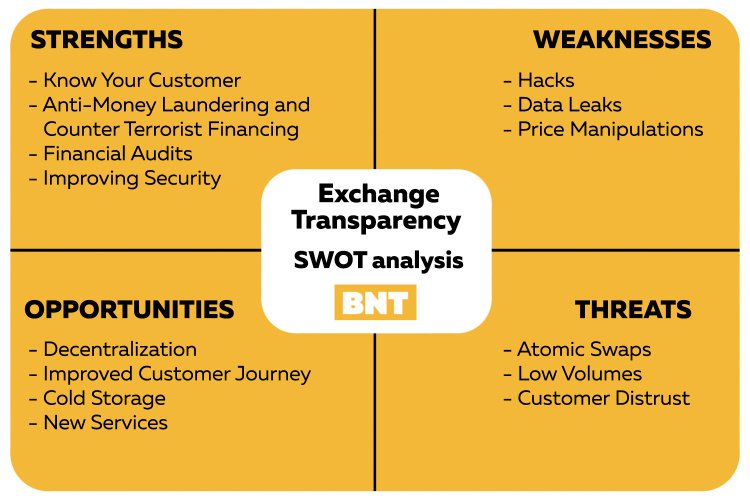Exchange Transparency SWOT-Analysis: Consider It Before You Deposit

Cryptocurrency exchanges have faced an uphill battle over the past several years. Hacks, scams, corporate shutdowns, and more are all symptoms of one huge underlying problem in the industry: transparency. As exchanges fail to keep users and local regulators informed of their business practices, security, and finances, it leaves the door open for the entire market to wonder about the validity of their statements. Let’s take a look at transparency being a cornerstone for the development of the crypto exchange business as a whole, and undertake a SWOT-analysis of exchanges going fully transparent: what is the advantage and where is the possible vulnerability?
Strengths
One benefit of major exchange compromises over the past decade has been a resulting increase in measures taken by exchanges to provide protection and security to their users. Overall, the exchange industry is light years ahead of its early days with Mt.Gox. Security and financial audits are becoming best practices in the industry, with exchanges providing significant insight into the security measures taken to keep investors safe, as well as displaying their financial strategies to potential users.
‘Know Your Customer”, as well as AML/CFT, is a generic demand from regulators when an exchange is aimed at doing business within fully transparent frameworks. The task forces are not dormant and work towards fighting the issues mentioned above, as well as tax-evasion practices. “Internal Revenue Service-Criminal Investigation (IRS-CI) indicated that it bolstered its staff by ten additional new investigators to make it easier to track down cross-border crypto tax evaders. The U.S. Immigration and Customs Enforcement (ICE) indicated that it uses undercover techniques to infiltrate and exploit peer-to-peer cryptocurrency exchangers who typically launder proceeds by using mixers,” commented Selva OZELLI, the International Tax Attorney and CPA. Thus, following the rules of AML/CFT puts an exchange on a list of respectable, legal and compliant business in every possible jurisdiction.
Weaknesses
Even with the increase in security audits and transparency, the industry is still riddled with exchange hacks, thefts, and suspicious activity. In September, the Japanese exchange Zaif was compromised with $60 million worth of digital currency stolen, and earlier in 2018 Coincheck lost $400 million worth of NEM coins when its exchange was compromised. Every time an exchange is hacked, or found out to be a fraudulent company, it adds fuel to the fire for cryptocurrency detractors and sets the entire industry back.
Despite the fight for transparency and security, the current situation deters customers due to the instability. Just recently, the South Korean National Police Agency released a report concerning cryptocurrency and wallet hacks which took place in the country since 2016. The amount of “illegally withdrawn through hacking was 112 billion won (~$99 mln),” according to the report. As lawmaker Min KYUNG-WOOK commented to the local media: “The nature of cryptocurrency exchanges is presented continuously to cyber threat… the hacking mishaps happened even in the spots where the administration led security checks.”
The total transparency of information on crypto exchanges is also opposed mostly by the users which are not looking forward to sharing their personal data despite the demands of KYC. According to these enthusiasts, personal data is also vulnerable and may be obtained by the third-party persons with no good intentions as well.
Opportunities
The industry is barely a fraction of what it could become in the coming years and decades. This gives any cryptocurrency exchange, which is able to provide its customers a safe, transparent platform for exchanging new assets, a limitless potential. Services such as Binance and RightBTC are examples of exchanges providing users with added layers of security and transparency, such as two-factor authentication, high-level SSL encryption, cold storage, and more. Exchanges which are taking these extra precautions and giving users a fully transparent look into their businesses will flourish in the upcoming years.
The advent of decentralized, and peer-to-peer exchange trading aligns better with the values of blockchain and could also become an increasingly large part of the exchange ecosystem. Exchanges such as Waves, CryptoBridge, and DEX are good examples of decentralized exchanges making a name for themselves with traders and investors. Lots of competitors understand the current trends of decentralization and self-regulation services and move according to that vector, says Adam FUNNEL, crypto trader and investor from UK: “There is a buzz around the evolution of these exchanges and rightly so! As they become more user friendly and with brands such as Binance, announcing their own decentralised exchanges, they will become more widely used. The crypto industry is in its infancy, but it is wonderful to see how it gets self-regulated and how transparent exchanges become. Due to the acts of certain exchanges and fraudulent players, self-regulation has been rapid and effective. Users expect and receive certain standards and transparency and these standards help to inform and protect them.”
Threats
New technology in the cryptocurrency industry has the potential to make exchanges obsolete. Atomic swaps are being designed to allow for seamless conversion between cryptocurrencies without an exchange acting as a trusted third party. The direct exchange between blockchains could be a game-changer for the industry. If this technology becomes ubiquitous, exchanges will lose a significant amount of their potential value, and may only be used to exchange fiat for the cryptocurrency, despite the transparency they propose.
Conclusion
After close to ten years of growth, it is clear that the cryptocurrency market is only becoming more ubiquitous across the world. This gives cryptocurrency exchanges a great opportunity to build businesses to support this growing industry. At the same time, exchanges are still seen by many as unsafe and unsecure for transacting, and until this stigma is squashed, exchanges may have a difficult time seeing the growth they are looking for. They understand and work on it, boosting the strengths and making everything to dismiss the weaknesses.